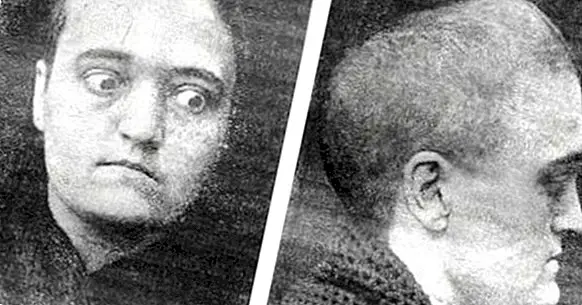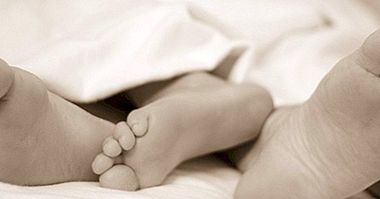Crouzon syndrome: symptoms, causes and intervention
At birth, most human beings have a malleable skull which allows us to come to the world through the birth canal. These bones are going to be closing and suturing with age, as our brain grows in size and maturing.
However, there are cases of different disorders in which said suture occurs prematurely, which can affect both the morphology and the functionality of the brain and various facial organs. One of the disorders that people are talking about Crouzon syndrome, a hereditary disorder of genetic origin.
The Crouzon Syndrome
Crouzon syndrome is a disease of genetic origin characterized by the presence of a craniosynostosis or suture of the bones of the premature skull. This closure causes the skull to have to grow in the direction of the sutures that remain open, which generates malformations in the physiognomy of the skull and face.
These malformations can mean serious complications for the correct development of the encephalon and the set of organs that make up the head, problems that are going to manifest themselves with the passage of time as the boy or girl grows.
Symptoms of Crouzon syndrome
The symptoms usually appear near the two years of age of the minor, not being generally visible at the time of birth.
The most obvious symptoms are the presence of a bulge of the skull with the upper and / or posterior parts flattened, as well as exophthalmos or projection of the eyeball to the outside due to the presence of shallow eye orbits, a compressed nasal cavity that hinders breathing in this way, the cleft palate and other malformations facial and buccal such as prognathism or forward projection of the jaw or alterations in the dentition.
However, the most relevant and dangerous are respiratory and alimentary difficulties , that can end up endangering your life. It is also possible that hydrocephalus and other neurological disorders may occur. Intracranial pressure is also higher than usual, and seizures may occur
All these difficulties can cause the child to have severe problems along its growth such as dizziness, frequent headaches and perceptual problems both in vision and in hearing.
With regard to the ocular alterations , the prominence of these causes that they are prone to infections and even to the atrophy of the visual system, being able to lose the vision.
In addition, facial malformations hinder the learning of oral communication, which tends to generate a delay in learning. In any case, despite the fact that these malformations could affect intellectual development, in most cases the subjects with Crouzon syndrome usually have an intelligence in the average corresponding to your developmental age.
Causes of this syndrome (etiology)
As mentioned previously, Crouzon syndrome is a congenital and inherited disorder of genetic origin. Specifically, the cause of this syndrome can be found in the presence of mutations in the FGFR2 gene , or fibroblast growth factor receptor, on chromosome 10. This gene is involved in cell differentiation, and its mutation causes an acceleration of the suture process of some or all of the bones of the skull.
It is an autosomal dominant disease , so that a person with this mutation has a 50% chance of transmitting this disease to their offspring.
Treatment
Crouzon syndrome is a congenital condition without a cure, although some of its complications can be avoided and / or the impact of its consequences can be reduced. The treatment to be applied must be interdisciplinary , with the help of professionals from different branches such as medicine, speech therapy and psychology.
Surgery
In a large number of cases part of the problems can be corrected through the use of surgery. Specifically, cranioplasty can be used to try to equip the child's head in a way that allows the normative development of the encephalon and in turn relieve intracranial pressure (which also makes it possible to avoid to a large extent the usual headaches that usually suffer, which in many cases results in this pressure). It can also be used to treat a possible hydrocephalus derived from the abnormal growth of the brain.
Also, it can be very useful to surgical intervention of the nasal and bucco-pathways , so as to facilitate breathing and passage of food through the digestive tract and solve problems such as prognathism and cleft palate.Dental surgery may also be necessary, as the case may be.
The eyes can also benefit from treatment by surgery, reducing exophthalmia as much as possible and with it the possibility of the visual organs becoming dry or becoming infected.
Logopedia and education
Due to the difficulties that can cause malformations in the phonatory system , the use of speech therapist services is very useful. The language can be altered and delayed, so you have to take into account their difficulties and provide adequate help. In cases where there is an intellectual disability, this must also be taken into account when adjusting the education and training of the minor.
Psychotherapy
The psychological treatment and advice to the minor as well as to family and educators is fundamental in order to understand the situation of the affected person and allow the expression of doubts and fears and the resolution of psychological and emotional problems derived from the experience of the disorder for both the child and his environment.
Bibliographic references:
- Beltrán, P .; Rosas, N. & Jorges, I. (2004). Crouzon syndrome. Journal of Neurology. twenty-one).
- Hoyos, M. (2014). Crouzon syndrome. Rev. Act. Clin. Med .: 46. La Paz.
- Liu, J .; Nam, H.K .; Wang, E. & Hatch, N.E. (2013). Further analysis of the Crouzon mouse: effects of the FGFR2 (C342Y) mutation are cranial bone-dependent. Clcif. Tissue Int. 92 (5): 451-466.



















